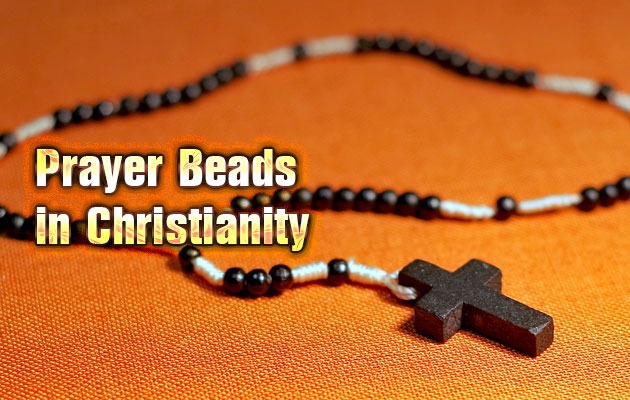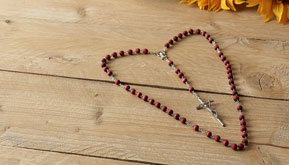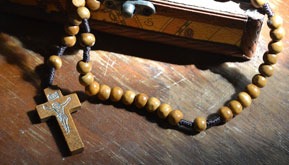Who uses prayer beads?
Most people, when they think of prayer beads, immediately think of rosary beads. While these may be the most common, they are far from the only ones out there. Many different religions make use of prayer beads, including Hindus, Buddhists, Muslims, Sikhs, Baha’I, and, of course, Christians. Beads have been used for thousands of years; the earliest dated are believed to be from 10,000 BC.
While the Catholic rosary is, again, the most well-known, other denominations also use beads to keep track of, or as reminders for, prayers. These include Catholics, Anglicans, Eastern Orthodox, Episcopalians, and Lutherans, and, surprisingly, some other Protestants.
The Old English word bede, from which we get the word bead, actually means “a prayer.”
 What materials are used for prayer beads?
What materials are used for prayer beads?
Prayer beads are usually made of colored glass or plastic, but they can be made of nearly anything, including olive wood or other wood, porcelain, coral, amber, quartz, precious stones, paper, bone, or rose petals (which was occasionally done with early rosaries). Some denominations use knots either instead of or along with beads. Some are styled more like a ladder, with two parallel strands and the beads affixed between them.
How many prayer beads are used?
The number of beads contained in a string of prayer beads depends on which tradition is using them, and in which form.
Full Catholic rosaries are made with five decades (sets of ten beads), divided by larger beads, with a set of five beads and a crucifix attached at one point. This resulted in a total of 59 beads, plus the crucifix.
Catholic rosary bracelets and rings consist of a single decade with a larger bead or small cross. These are often known as chaplets.
Eastern Orthodox prayer ropes consist of 33, 50, or 100 either knots or beads, the most common being 100 (three sets of 33 plus a connector/pendant). There are rare ones that have 150, 300, or 500. Many have a tassel attached for the purpose of drying tears. They are also sometimes called “Chotki.”
Oriental Orthodox ropes have 41, 64, or 100 beads.
Anglican prayer beads have 33, divided into four groups of seven with larger beads dividing the groups.
Protestant sets usually consist of 34 beads plus a pendant: four groups of seven divided by larger beads, plus a ‘tail’ of two beads culminating in the pendant.
 What do the prayer beads mean?
What do the prayer beads mean?
Again, this differs by tradition. However, most beads have some meaning attributed to them by placement, though some Protestants declare their prayer ropes a blank slate, to be ascribed whatever meaning one prefers.
In a Catholic rosary:
- Each of the five decades is linked to a certain prayer
- The larger divider beads are linked to a different prayer
- Each decade stands for a different “Mystery of the Rosary” – meditations on parts of Jesus’ life and death, and, usually, a spiritual goal (or fruit).
Eastern Orthodox prayer ropes:
- Commonly made of wool, to symbolize being the flock of Christ
- Traditionally black to symbolize sadness for one’s sins
- Beads and at least part of the tassel are often red, symbolizing blood (of Jesus and/or martyrs)
- Tassel to symbolize the glory of the Heavenly Kingdom
- Sets of 33 to symbolize the age of Jesus Christ at His crucifixion, or sets of 50 that equal 150 to represent the Psalms
Oriental Orthodox sets:
- Either 41 beads to represent the 39 lashes plus the lance and crown of thorns, 64 beads to represent Mary’s age at Assumption, or 100 beads as other Orthodox traditions.
Anglican prayer bead sets:
- 33 beads represent the years Jesus Christ lived on earth
- 7 in each set to represent completion in the faith, the Creation days, and the Church year seasons
Protestant prayer beads:
- Usually four sets, so the divider beads form a cross
- Sets contain seven beads, to form “Weeks”
- The smaller ‘tail’ bead represents the resurrection
- The larger ‘tail’ bead is known as the “invitatory” bead, and represents a call to worship or a conclusion
How are prayer beads used?
This is one thing all faiths have in common, though the prayers used differ: as an aid to repetitive prayer. Each bead is assigned to a prayer or meditation, in which it is most often repeated for each bead within a section and divided by a different prayer or meditation between. In some, the same prayer is used throughout for the same size bead, while in others, each section has a different prayer that is repeated within it.
Catholic
For Catholic rosaries, the supplicant repeats the Hail Mary for each small bead, and the Lord’s Prayer for each of the larger beads. Generally, the decades are also associated with a set of Mysteries, which numbered 15 until Pope John Paul II added five more in 2002. These Mysteries include five Joyful Mysteries (the Annunciation, the Visitation, the Nativity, the Presentation of Jesus at the Temple, and the Finding of Jesus in the Temple), five Sorrowful Mysteries (the Agony in the Garden, the Scourging at the Pillar, the Crowning with Thorns, the Carrying of the Cross, and the Crucifixion and Death of our Lord), the Glorious Mysteries (the Resurrection, the Ascension, the Descent of the Holy Spirit, the Assumption of Mary, and the Coronation of the Virgin), and the Luminous Mysteries (the Baptism of Jesus in the Jordan, the Wedding at Cana, Jesus’ Proclamation of the Kingdom of God, the Transfiguration, and the Institution of the Eucharist). These are meditated on during prayer through each section of the Rosary.
Some choose to do a different single Mystery (set of five) per day rather than praying all fifteen or twenty daily.
Eastern Orthodox
In the Eastern Orthodox tradition, the prayer rope is used for the Psalms, or for the Jesus Prayer mostly. The Jesus Prayer is a variation of “Lord Jesus Christ, have mercy on me, a sinner.” The Psalms are also known as the Psalter, which is divided into 20 Kathismata.
Oriental Orthodox
Worshippers following the Oriental Orthodox tradition use the beads as an aid to recite the Jesus Prayer, and possibly the Lord’s Prayer and the Magnificat (Mary’s prayer from Luke 1).
Anglican
Usually the set of Anglican prayers begins with the cross, then each bead and around, and back to the cross (though the cross and its accompanying beads are option for ending). The prayer associated with the cross is the simple declaration, “In the Name of God, Father, Son, and Holy Spirit. Amen,” followed by entreaty for salvation and help. The weeks are what is known as the “Jesus Prayer,” with the cruciforms glorifying God and again requesting mercy. Some finish up with the Lord’s Prayer and a blessing to the Lord.
Protestant
While it is not common for Protestant and other non-Catholic denominations to use prayer beads, those that do have different ways of using them. It is generally suggested to create one’s own prayer plan. Some choose friends or family to associate with each bead. Others use it to glorify God by focusing on a different aspect of His character for each bead. Another option is to pray for the fruit of the Spirit (love, joy, peace, patience, gentleness, goodness, faith, meekness, self-control) for yourself or others.


 What materials are used for prayer beads?
What materials are used for prayer beads? What do the prayer beads mean?
What do the prayer beads mean?